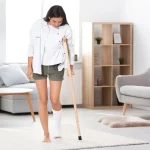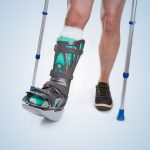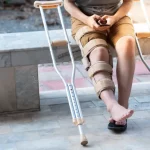A heel fracture is a serious injury that can significantly affect your daily life and activity. It is one of the most load-bearing areas of our body, playing a key role in walking and balance. Understanding the mechanisms and causes of such a fracture, as well as knowledge about the consequences and methods of recovery, is the first step towards successful rehabilitation. Whether your fracture is the result of an accident or a chronic condition, the right approach to rehabilitation can greatly improve the treatment outcome. To help you on your way to recovery, we offer a series of video exercises specially designed for heel fracture rehabilitation. Watch them on our website to start your journey to recovery today.
Discussion of the most common causes, including falls from height and direct impacts, that lead to heel fractures, as well as risk factors contributing to this type of injury.

When Can You Start Home Rehabilitation with Our Subscription?
A heel fracture is a serious challenge that can significantly affect your ability to move and lead an active life. Our subscription offers you access to video exercises developed based on Israeli protocols for effective rehabilitation right in your own home.
It is important to start rehabilitation at the right time:
- Acute Phase: It is recommended to begin exercises after the acute pain subsides and inflammation decreases, which usually takes several weeks.
- Consultation with a Doctor: Always consult with your physician or orthopedist before starting any home exercises to ensure they are suitable for your condition.
What Do You Get with the Subscription?
- Video Instructions: Our detailed videos teach the correct execution of exercises, which is crucial to prevent further injuries and expedite recovery.
- Written Instructions and Infographics: Access additional resources, including written instructions and infographics, for a full understanding of the recovery process.
- Individualized Repetition Recommendations: We provide clear recommendations on the number of repetitions and intensity to ensure a safe increase in workload during recovery.
Why to Choose Home Rehabilitation
- Personal Comfort: Perform exercises in the comfort of your own home, at a time convenient for you.
- At Your Pace: Home rehabilitation allows you to adjust the pace according to your personal sensations and the rate of recovery.
- Unlimited Access to Resources: You can access videos and instructions anytime, which provides flexibility in your recovery plan.
- Support and Convenience: Recover in the familiarity and comfort of your home, where you feel more confident and relaxed.
Try our subscription for effective and comfortable recovery after a heel fracture.
Watch Rehabilitation Exercises After Heel Fracture Videos
Video: “Exercises for STRENGTHENING OF THE MUSCLES AND IMPROVEMENT OF PROPRIOCEPTION AND STABILITY OF THE ANKLE AND ENTIRE LOWER LIMB”
EXERCISES FOR THE ANKLE JOINT. SET №6E IS AIMED AT STRENGTHENING OF THE MUSCLES AND IMPROVEMENT OF PROPRIOCEPTION AND STABILITY OF THE ANKLE AND ENTIRE LOWER LIMB. MID STAGE
For additional information about the recovery process you can watch a video demonstrating exercises and rehabilitation recommendations.
Diagnosis of Heel Fracture
Accurate diagnosis of a heel fracture is a key step in planning effective treatment and rehabilitation. It is important to determine precisely the extent and nature of the injury to select the most appropriate treatment method. Here are the main aspects to be considered in the diagnosis of a heel fracture:
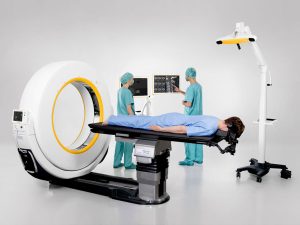
Clinical Diagnosis and Initial Assessment
- Examination and medical history: At the initial stage, the doctor conducts a thorough examination of the affected area, asks about the patient’s symptoms and the circumstances of the injury.
- Symptom assessment: Key symptoms of a heel fracture include severe pain, swelling, redness, as well as limited mobility and the ability to bear weight on the foot.
- Palpation and sensitivity tests: The doctor performs palpation to identify precise points of tenderness and checks for the presence of swelling.
Instrumental Diagnostic Methods
- X-ray: The standard and most accessible method for diagnosing fractures. X-ray images help determine the location, type, and extent of the fracture.
- Computed Tomography (CT): Used for a more detailed assessment of complex fractures. CT can detect fragmented and complex fractures that may not be visible on regular X-rays.
- Magnetic Resonance Imaging (MRI): Prescribed in the cases when information about soft tissues, tendons, and ligaments around the heel is needed. MRI is especially useful for detecting injuries that may accompany the fracture, such as ligament tears.
After establishing an accurate diagnosis, the doctor develops a treatment and rehabilitation plan, which may include surgical intervention, immobilization, and subsequent physiotherapy. It is important to follow carefully the recommendations for a successful recovery.
Initial Stage of Heel Fracture Treatment
The first steps after a heel injury are critically important to ensure a successful treatment outcome and minimize the risk of complications. The initial stage of heel fracture treatment includes several key aspects:
First Aid and Immediate Therapy
- Immobilization: The most important step is immediate immobilization of the affected area. This helps prevent further damage and reduces pain.
- Cold: Applying cold to the injured area can help reduce swelling and pain. It is recommended to use cold compresses during the first 24-48 hours after the injury.
- Elevation: Elevating the leg above heart level helps reduce swelling and accelerates recovery.
- Pain Relief: Pain relievers/analgesics may be prescribed to alleviate pain.
Surgical Intervention and Immobilization
- Assessment of the need for surgical intervention: Depending on the type and complexity of the heel fracture, surgical intervention may be required to restore the proper alignment of bone fragments.
- Surgical Methods: This may involve open reduction and internal fixation using metal plates, screws, or nails to stabilize the fracture.
- Immobilization after surgery: After surgical intervention, a period of immobilization using a cast or orthopedic boot is usually necessary to protect the injured area and ensure proper healing.
- Rehabilitation after surgery: Early mobilization and rehabilitation are extremely important after surgical treatment of a heel fracture to regain range of motion, strengthen muscles, and prevent the development of contractures and atrophy.
The approach to treating a heel fracture should be individualized and based on the specific characteristics of the injury. It is important to collaborate closely with your doctor and follow all their recommendations to achieve the best recovery results.
Basics of Heel Fracture Rehabilitation
Rehabilitation after a heel fracture is a key element of the recovery process. This stage aims not only to return to previous levels of physical activity but also to prevent long-term complications, such as heel pain, limited mobility, and the development of arthritis. Here are the main aspects of the rehabilitation process:
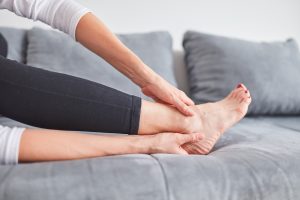
Goals and Objectives of the Rehabilitation Process
- Restoring Mobility and Flexibility: After a period of immobilization, it is important to regain range of motion in the heel and ankle.
- Muscle Strengthening: Special attention is paid to strengthening leg muscles to provide support and stability to the heel.
- Improving Coordination and Balance: Balance and coordination rehabilitation exercises are necessary to prevent recurrent injuries.
- Pain and Swelling Reduction: Pain control and reducing swelling are essential parts of the rehabilitation process.
- Enhancing Overall Functionality: The goal is to return to daily activities and, if possible, a more active lifestyle.
The Importance of Early Mobilization and Complication Prevention
- Early Mobilization: Starting rehabilitation exercises as early as possible helps accelerate the recovery process.
- Complication Prevention: Regular exercises and physiotherapy help prevent complications such as joint contractures, muscle atrophy, and chronic pain.
Stages of the Rehabilitation Process
Rehabilitation after a heel fracture is typically divided into several stages, each with its own goals and approaches:
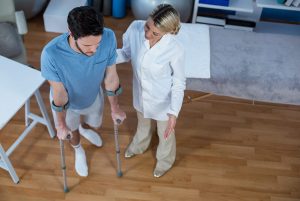
Acute Stage of Recovery
During this stage, the primary focus is on reducing pain and swelling, as well as preventing complications related to immobilization. This includes gentle exercises to improve circulation, gentle stretching, and the use of cold therapy to reduce swelling.
Subacute Stage of Recovery
At this stage, more active physiotherapy begins, aimed at restoring range of motion, strengthening muscles, and improving the general condition of the heel and lower limb. Exercises become more intensive and targeted.
Late Stage of Recovery
The final stage of rehabilitation is focused on returning to daily activities and work. The exercise program includes specialized training to enhance functionality and prevent injury recurrence. During this period, it is also important to focus on adapting your lifestyle and work environment to minimize the risk of future injuries.
Rehabilitation Methods for Heel Fractures
Rehabilitation after a heel fracture involves various methods and procedures, each playing a crucial role in the recovery process. Here are some key procedures used in rehabilitation:
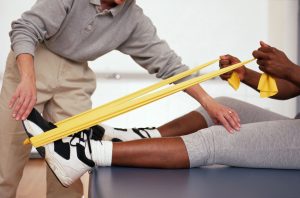
Physiotherapy
- Manual Therapy: This includes massage, joint mobilization, and gentle stretching techniques to improve blood circulation, reduce pain, and restore mobility.
- Stretching and Strengthening Exercises: These exercises are aimed at improving flexibility, strengthening muscles, and restoring range of motion in the heel and ankle.
- Balance and Coordination Exercises: These exercises help regain control and confidence in walking, improve general stability, and prevent falls.
Occupational Therapy and Adaptation to Daily Life
- Adaptive Techniques and Devices: Providing advice and teaching how to use adaptive devices such as crutches or walkers to facilitate mobility during recovery.
- Training of Daily Activities: Rehabilitation focuses on restoring the ability to perform daily activities such as dressing, getting out of bed, and moving around the home.
Hydrotherapy
- Water Exercises: Performing exercises in water helps reduce stress on the heel, making movements easier and accelerating recovery.
- Water Procedures: Hydrotherapy baths and swimming can contribute to the improved circulation and pain reduction.
Cryotherapy and Heat Therapy
- Cold Application: Using cold compresses to reduce swelling and pain in the initial days after the injury.
- Heat Therapy: Applying heat in later stages to relax muscles, reduce pain, and improve circulation.
Electrotherapy
- TENS (Transcutaneous Electrical Nerve Stimulation): Using low-frequency currents for pain relief and improved circulation.
- Ultrasound Therapy: Applying ultrasound waves to accelerate the healing process and reduce inflammation.
These rehabilitation methods should be individualized and applied according to each patient’s needs, the severity of the injury, and their general health. It is essential to work closely with healthcare professionals to determine the optimal recovery program.
Exercises for Restoring Heel Function
Exercises for rehabilitation after a heel fracture should be selected based on the stage of recovery. Here is a list of 25 exercises covering various stages of rehabilitation:

Initial Stage of Recovery:
- Seated Toe Raises: Lift your heels off the floor while sitting on a chair.
- Circular Foot Movements: Rotate your foot clockwise and counterclockwise, performing circular motions.
- Toe Curling and Extension: Actively curl and extend your toes.
- Seated Calf Stretch: Pull a towel towards yourself, holding its ends and wrapping it around the sole of your foot.
- Ball Squeezes with Your Foot: Squeeze and release a ball with your foot.
Subacute Stage of Recovery:
- Heel Walking: Walk on your heels in a straight line.
- Standing Calf Raises: Rise up onto your toes while standing and using a wall for support.
- Ball Rolling with Your Foot: Roll a tennis ball forward and backward under your foot.
- Standing Calf Stretch: Push off a wall with your foot, stretching the calf muscles.
- Single Leg Balance: Stand on one leg, maintaining balance.
Advanced Stage of Recovery:
- Weighted Toe Raises: Perform toe raises while holding dumbbells in your hands.
- Wall Squats: Slowly squat down while leaning against a wall.
- Step-Ups on a Platform: Step up and down using a step platform.
- Stair Climbing: Walk up and down stairs, focusing on your heel.
- Pigeon Pose Stretch for the Ankle: Sit on the floor, cross one leg in front of you, and bend forward.
Exercises for Strengthening and Flexibility:
- Yoga Poses for Leg Strengthening: Perform poses that strengthen the leg and foot muscles, such as “Warrior” or “Tree” pose.
- Pilates Exercises for Legs: Use Pilates techniques to strengthen and improve flexibility.
- Resistance Band Pull: While sitting in a chair, pull a resistance band attached to your leg.
- Light Jogging in Place: Start with light jogging in place and gradually increase the intensity.
- Walking on Uneven Terrain: Walk on soft, uneven surfaces like sand or grass.
Exercises for Balance and Coordination Improvement:
- Walking Along a Line: Walk along a straight line, trying not to step off it.
- Balancing on a Stability Ball: Use a large stability ball to improve balance and coordination.
- Standing on a Bosu Ball: Stand on one leg on an unstable surface, such as a Bosu ball.
- Slow Dancing: Dance slowly, focusing on controlling leg and foot movements.
- Tai Chi or Qigong: Practice Tai Chi or Qigong to enhance coordination and inner harmony.
Each exercise should be performed considering individual tolerance to the load and only after consulting with a healthcare professional.
Diet and Lifestyle During Rehabilitation
Diet plays a crucial role in the recovery process after a heel fracture. Adequate diet can expedite bone healing, reduce inflammation, and improve general health. Here is a list of foods that can contribute to effective rehabilitation:

- Calcium-Rich Foods: Dairy products (such as milk, yogurt, and cheese), leafy green vegetables (e.g., broccoli and cabbage), and calcium-fortified products like orange juice. Calcium is essential for bone strength.
- Protein-Rich Foods: Meat, fish, eggs, legumes, and nuts contain protein necessary for tissue repair and recovery.
- Vitamin D-Rich Foods: Fatty fish (like salmon and sardines), mushrooms, and vitamin D-fortified foods. Vitamin D aids in calcium absorption and bone strengthening.
- Omega-3 Fatty Acid-Rich Foods: Omega-3s found in fish, such as salmon, and flaxseed oil can help reduce inflammation.
- Fruits and Vegetables: They are rich in vitamins, minerals, and antioxidants that fight inflammation and promote general health.
- Whole Grains: Brown rice, oats, and whole-grain bread contain complex carbohydrates and fiber that support energy levels and digestion.
- Water and Hydration: Maintaining proper hydration is essential for recovery and prevents a slowing of metabolism.
- Vitamin K-Rich Foods: Leafy greens like spinach, kale, and green lettuce contain vitamin K, which plays a vital role in bone healing.
- Magnesium-Rich Foods: Pumpkin seeds, almonds, avocados, and bananas are magnesium sources that help calcium absorption and bone health.
- Iron-Rich Foods: Beef, spinach, and legumes contain iron necessary for preventing anemia and improving oxygen delivery to tissues.
In addition to diet, it is crucial to maintain a healthy lifestyle, including quitting smoking and moderate alcohol consumption, as these factors can slow down the healing process. Regular light exercises and adequate rest also contribute to a faster recovery.
Psychological Support in the Rehabilitation Process
Psychological support is an integral part of the rehabilitation process after a heel fracture. The recovery period can be emotionally challenging for patients as they face mobility limitations, pain, and changes in their daily lives. Here’s how psychological support can help:

Managing Stress and Anxiety
- Relaxation Techniques: Practices such as meditation, deep breathing, and relaxation exercises can help reduce stress and anxiety.
- Cognitive-Behavioral Therapy (CBT): This form of psychotherapy helps patients change negative thoughts and behaviors related to their injury and recovery.
The Importance of Psychological Support and Motivation
- Support Groups: Participating in support groups where people share their experiences and strategies for overcoming difficulties can be highly beneficial.
- Individual Counseling: Working with a psychotherapist or psychologist can help patients better cope with emotional challenges.
Conclusion
Real-Life Example: Maria, a 45-year-old woman, suffered a complex heel fracture and experienced significant difficulties during her rehabilitation. She felt depressed and isolated due to her inability to move and participate in her usual activities. During her rehabilitation, Maria began seeing a psychologist who helped her develop coping strategies for dealing with stress and anxiety. They worked on reframing her attitude toward recovery, focusing on progress rather than limitations. Maria also joined a support group where she could interact with others experiencing similar challenges. These measures allowed her to look at the recovery process in a new light and contributed to her emotional well-being and motivation.
Thus, psychological support plays a crucial role in the recovery process, helping patients adapt to new circumstances, manage emotions, and find their internal resources for successful rehabilitation.




